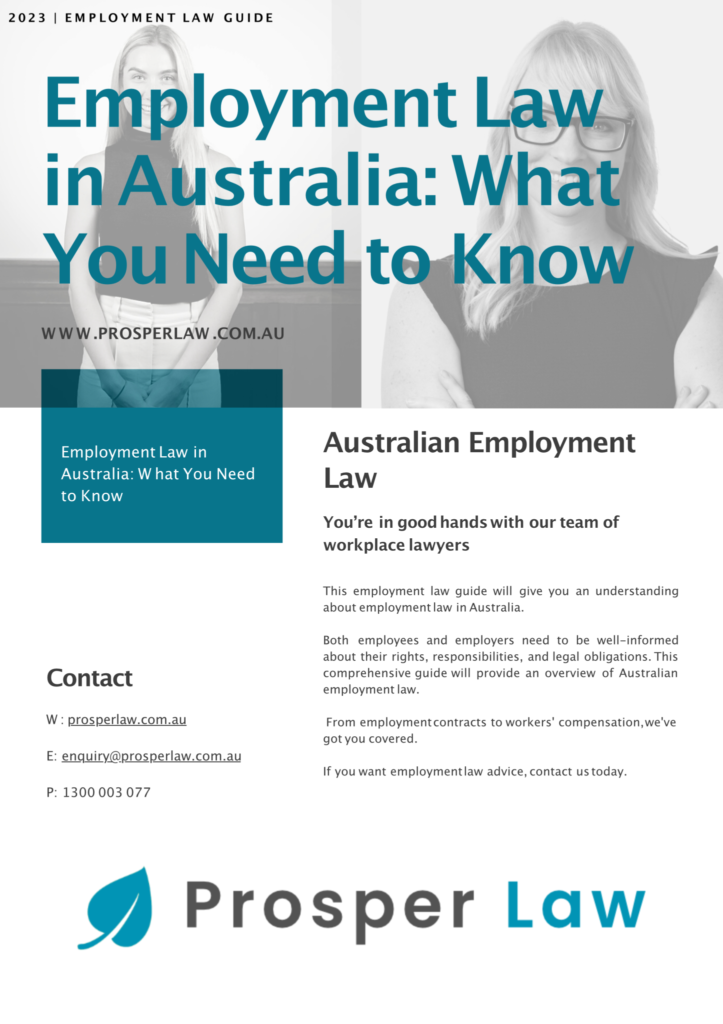A forced resignation is when an employee has no real choice but to resign.
It can occur when the:
- employee feels they have no real choice but to resign because of the conduct of the employer; or
- employer has engaged in certain conduct intending to bring the employment to an end.
The employee must prove that their resignation was not voluntary and that someone forced them to leave.
In this article, our employment lawyers, dive into the elements of forced resignation, examples of it occurring and an employees rights when they are forced to resign.
Key takeaways
- Forced resignation occurs when an employee quits because of the employer’s actions.
- Employees must prove their resignation was because of employer conduct, requiring evidence and legal support.
- Employers may face legal repercussions such as compensation and damage to reputation for forcing a resignation.
- Proving forced resignation or constructive dismissal means showing employer’s intention, lack of employee’s choice, and direct impact on employment.
- Employers should openly communicate with their employees. They should also create a positive work environment. Additionally, it is important for employers to set clear rules and provide feedback to their employees. Lastly, employers should seek legal advice for any complicated employment issues.
What are the elements of forced resignation in Australia?
To establish a case of forced resignation, the burden of proof lies with the employee. They must demonstrate that they did not voluntarily resign and that someone coerced or compelled them to leave their job. When an employee successfully proves forced resignation, the company treats it as constructive dismissal.
Elements contributing to forced resignation in Australia include:
- Unreasonable workload. When the employer assigns an employee an excessive amount of work that they cannot do within a reasonable timeframe.
- Bullying or harassment. This can include verbal abuse, intimidation, unwanted physical contact, or even creating a hostile work environment. It can be isolating and emotionally draining, making it difficult to continue working.
- Discrimination. Treating someone unfairly based on their race, gender, religion, sexual orientation, disability, or any other protected characteristic. This can be blatant or subtle, but it can make an employee feel unwelcome and undervalued.
- Underpayment or non-payment of wages. Not receiving payment or experiencing unexplained wage delays. This can cause financial hardship and make it difficult to make ends meet. Learn more about underpayment of wages.
- Unsafe working conditions. Exposing workers to hazardous materials or equipment or assigning them to work in dangerous conditions. This can put an employee’s health and safety at risk and create a constant feeling of anxiety.

Does the act of forcing someone to resign hold validity?
No. In most cases, a forced resignation is not legally acceptable. However, if an employer creates a hostile work environment that compels an employee to quit, it can be seen as constructive dismissal, which may be considered as an unfair termination.
Consequently, the employee has the right to file an unfair dismissal claim against the employer.
Test for forced resignation or constructive dismissal
A step-by-step breakdown of the key elements that constitute forced resignation or constructive dismissal.
- Intent or Probable Result. We must determine if the employer wanted to fire the employee or if their actions made the employee quit.
- Lack of a genuine choice. We need to think about if the employee had a real choice to quit because of how the employer acted. If the employer’s actions or changes left the employee with no choice but to resign, constructive dismissal exists.
- Direct impact on employment. The employer’s actions must have a direct or consequential effect on the termination of employment. This means that the employee’s resignation must result directly from the employer’s actions. Without these actions, the employee would have continued the employment relationship.
- The employer’s behaviour is the main cause. Proving that the employer’s actions or behaviour were the main cause of the resignation is crucial. The employer’s actions made it impossible to continue working or accept. Consequently, the employee had no other reasonable option but to resign.
- Evidence of unfair treatment. If there is evidence of unfair treatment, changes in working conditions, bullying, pay cuts, demotions or other behaviour that significantly changes the nature of the employment and forces the employee to resign.
Whether these factors and the situation of the job consider it constructive dismissal. However, it is important to consult an employment lawyer to assess the specific details of the case.

When is there a Forced Resignation or Constructive Dismissal?
Failure to pay wages
- The employer failed to provide a valid reason for dismissal.
- No one gave Hobbs notice or a chance to address the non-payment issue.
- The employer didn’t follow the Small Business Fair Dismissal Code or show genuine redundancy.
When is there no Forced Resignation or Constructive Dismissal?
Now, let’s consider the scenarios where the company may not consider a resignation as forced.
Employee discussing terms after a change in their job role resigned
In Blair v Kim Bainbridge Legal Service Pty Ltd, Ms. Blair resigned. According to her, her employer was forcing her to accept a lower pay rate or leave her job. However, an investigation revealed that Ms. Blair had misunderstood the situation.
Her employer hadn’t made a final decision about Ms. Blair’s job conditions and was still discussing them with her. They concluded that the employer didn’t force Ms. Blair’s resignation. No definitive demands or threats of termination existed. Instead, her resignation stemmed from a misunderstanding about the ongoing discussions regarding her employment conditions.
This case shows how important it is for employers and employees to communicate clearly during job changes. Confusion about work conditions can lead to early job resignations, even if the employer disagrees with the employee’s perspective. It underscores the significance of clarifying and finalising terms before assuming the necessity of resignation.
Resignation by a suspended employee
In Davidson v Commonwealth, Mr. Ross Davidson, a DCCEE employee, claimed constructive dismissal after filing an unfair dismissal application. The employer objected to Fair Work Australia’s jurisdiction. They argued that Mr. Davidson voluntarily resigned rather than the employer terminating him.
Mr. Davidson quit because people thought he shared secret info and lied when getting security clearance. The DCCEE conducted an inquiry and suggested suspending Mr. Davidson until the investigation was complete.
However, Mr. Davidson was absent from work because of illness and was unable to access his work-related materials. He received a message stating his suspension, which led him to believe he was fired. Mr. Davidson refused to go back to work even though his employer wanted him to, saying he had already quit.
The ruling said the employer did nothing wrong and could investigate and suspend Mr. Davidson. The employer did not attempt to terminate his employment. The court said the employer gave Mr. Davidson enough chances to answer and go back to work. They decided that he quit because he didn’t understand the situation, not because the work environment was bad.
The employer didn’t fire Mr. Davidson, so they dropped the case. Additionally, he didn’t receive any help under section 394 of the Act.
Resignation for fear of disciplinary interview
In Pacific National (NSW) Limited v Bell, Mr. Bell quit before the company finished investigating his alleged timesheet falsification. Mr. Bell made this decision based on his own assessment of the situation and advice from his union representative.
Fair Work Australia found that Mr. Bell chose to resign, not because the employer made him. They emphasised that the employer’s actions did not coerce Mr. Bell into resigning. Instead, he based it on his own evaluation and the advice he received.
This case shows that resignations for fear of disciplinary interviews may not be considered forced resignations or constructive dismissals.
Poor employee treatment
In Lyne v Commissioner of Police, Fiona Lyne, an officer in the NSW Police Force, quit her job. She decided to leave because her manager, Jacqueline Goulding, created an unfriendly work environment. Fiona highlighted instances of alleged bullying, harassment, and unfair treatment by her manager, ultimately leading to her resignation.
She detailed several incidents over a period. The incidents included continuous harassment for being absent because of illness. Moreover, unfair targeting occurred for using sick leave because of severe health problems.
A sudden removal from training occurred because of health issues causing lateness. Lastly, they put her on a Performance Improvement Plan without valid reasons.
Further, Fiona reported verbal abuse from a colleague. She felt unfairly targeted in an investigation by the Professional Standards Command, causing her considerable stress and anxiety. She also expressed dissatisfaction with how her manager and higher management handled incidents.
Fiona’s resignation letter outlined her distressing experience, emphasizing the hostile work environment as the primary reason for her resignation. The ruling found the incidents concerning, but they didn’t prove the employer caused the contract to end.
Fiona had to undergo a medical assessment because of her sick leave record, which everyone considered fair. She decided to quit her job instead of going to the assessment. She tried to take back her resignation two days later, showing she wanted to keep working.
The commission dismissed Fiona’s claim of unfair dismissal and did not uphold her constructive dismissal claim.
Serious safety concerns
In Noble v Smiling Samoyed Pty Ltd, the employee quit because a colleague was bullying them. This bullying created an unsafe workplace environment. The worker lost trust in her boss and quit because he didn’t ensure her safety and health at work. However, the employer said that it had taken reasonable steps to address the conduct.
The Commission found that the employer did not engage in conduct intended to terminate the employment. The employer valued the employee and attempted to accommodate her health issues. Moreover, the employer clearly said they didn’t want the employee to quit in the morning when she resigned.
The Commission said that the employee had other options besides resigning. Someone suggested that the employee could have:
- opted for conflict resolution processes,
- attempted a temporary separation process recommended by the employer, or
- taken leave during the conflict resolution process.
The psychologist’s report didn’t understand the workplace dynamics, so it couldn’t prove the employer made the person quit.
The Commission understood why the employee resigned, but couldn’t prove that the employer’s actions caused her to quit. The employee had alternative avenues available to address the issue. Therefore, the Commission rejected her claim of constructive dismissal.
Read more on unfair dismissal cases and eligibility.
Employee Rights
Employees who have resigned under force or experienced constructive dismissal can pursue specific rights.
Unfair Dismissal Compensation
If an employee believes they received unfair dismissal, they can pursue compensation through the Fair Work Commission. This includes situations where the dismissal was harsh, unjust, or unreasonable.
Learn more about submitting an unfair dismissal application. And remember, there is a strict 21-day time limit on applications.
Legal Action for Breach of Contract
If an employer breaks the contract, employees can sue them. This can involve seeking damages or other remedies through the court system.
Entitlements and Severance
Workers who quit or were constructively fired may also be eligible for severance pay, unpaid wages, or benefits. This includes accrued leave, bonuses, or any other benefits owed according to their employment contract or relevant laws.
Frequently Asked Questions
What actions should an employee take if they believe someone is forcing them to resign?
Employees should seek advice from a union representative or employment lawyer. They can also file a complaint with the Fair Work Commission.
How can employers avoid forced resignation situations?
Employers should foster a positive and supportive work environment, address employee concerns promptly, and comply with all employment laws.
What are the potential consequences for employers who force employees to resign?
Employers who force employees to resign may face legal consequences, including:
- Unfair dismissal compensation. The Fair Work Commission may award employees compensation for unfair dismissal.
- Damages arising from breach of contract. Employee have the right to take legal action against their employers. This applies if someone forces them to resign in a way that violates their contract.
- Damage to Reputation. resignation can damage an employer’s reputation and make it difficult to attract and retain talent.
Can an employer force an employee to resign by offering a financial incentive?
While employers can offer financial incentives for voluntary resignations, they cannot pressure or coerce employees into accepting such offers. If a company pressures an employee to accept a financial incentive to resign, people may consider it forced resignation.
What are some tips for preventing forced resignation?
Here are some tips for preventing forced resignation:
- Maintain open communication with employees. Encourage employees to express their concerns freely and address them promptly.
- Create a positive and supportive work environment. Foster a culture of respect, inclusivity, and teamwork.
- Establish clear policies and procedures. Clearly define expectations and grievance procedures to ensure fair treatment.
- Provide regular feedback and performance reviews. Keep employees informed about their performance and provide opportunities for growth.
- Seek legal advice when dealing with employee issues. If faced with complex employee relations issues, consult with an employment lawyer.




